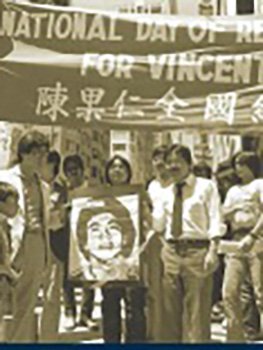Vincent Chin’s murder offers lessons in resisting anti-Asian hate
/Vincent Chin was murdered by white workers in 1982 amid an anti-Japanese hysteria resulting from the US car industry crash. (Source: Vincent Chin Institute)
Xenophobic scapegoating and protests--including violent public demolitions of Hondas, Datsuns (Nissan), and Toyotas--marked the hysteria. The toxicity eventually led to the racist murder of an Asian American.
In Detroit, on the night of June 19, 1982, enraged white auto plant supervisor Ronald Ebens, 47, and his stepson, Michael Nitz, 22, murdered Vincent Chin, a 27-year-old draftsman, who was celebrating with friends in a bar for his upcoming wedding.
A brief altercation had broken out when Ebens spewed racist slurs at Chin, blaming “people like (him)” for the massive unemployment of autoworkers. Ebens and Nitz were told Chin was Chinese American, not Japanese, yet they hunted him down outside the bar, even paying a bystander to point Chin out in a crowd, and battered him to death with a baseball bat.
Autoworkers demolishing a Japanese car during a protest (Source: Facebook)
Appallingly, a dismissive judge and the court system refused to rule the crime as murder, ignored the racist hatred that fueled it, and merely put the perpetrators on probation. They went free without even showing remorse.
Despite the court’s failure, Vincent’s mother, Lily Chin, never stopped trying to get justice for her son until she passed away in 2002; and many diverse community activists, who formed the American Citizens for Justice (ACJ) and fought by her side, never forgot.
A news clipping on the case, and Lily Chin with the Rev. Jesse Jackson (Source: Vincent Chin Institute)
Lily Chin addressing supporters (Source: Vincent Chin Institute)
Today, amid the recent wave of pandemic-triggered anti-Asian violence, Vincent’s supporters are reanimating his memory by launching the Vincent Chin Institute to help communities stem racist hate.
A teaching tool
In April last year, the institute began disseminating the Vincent Chin Legacy Guide, a teaching tool for K-12 students, educators, and the general public against anti-Asian discrimination and xenophobic and racist hate that often explode in times of economic and social crises.
Writer-activist Helen Zia, the guide’s editor and the executor of the Lily and Vincent Chin estate, stresses that the essential lesson from the tragic experience is “the urgency of forging unity, solidarity among various communities” and progressive individuals to resist racist attacks.
“Detroit had a very small Asian presence at the time of Vincent’s murder,” Zia, who was a laid-off autoworker herself, explains. “News reports on the murder didn’t even mention Vincent’s ethnicity,” giving the impression that it was the result of a typical bar fight. “And there was no internet that could help spread accurate information faster and wider,” she adds.
There were no Asian American legal advocacy groups in Detroit, and the Chin family could turn to only two in existence—one in New York, the other in San Francisco. Moreover, many immigrants in the largely invisible local Asian population also feared “making waves” and attracting “unwelcome” attention.
Yet, Zia says, several members of Chinese, Indian, Japanese, Filipino and other community groups that previously had only minimal interaction soon came together in the ACJ to help give the Chin family’s quest for justice a fighting chance.
Their united advocacy would eventually make the case better known across the country, especially among Asians, as a dreadful consequence of xenophobic vitriol.
Even after the justice system had failed the Chins, Zia continued to speak against anti-Asian attacks when they happened in schools and communities across Michigan and the rest of the country, always recalling Vincent Chin and the fact that his killers had yet to pay their debt to society.
Lessons in advocacy
Part of a national day of protests demanding justice for Vincent Chin (Source: Vincent Chin Institute)
At the Vincent Chin Institute’s launching in front of the US Capitol on April 26, 2024, Rep. Judy Chu, the first Chinese American member of Congress, emphasized the need for the institute and its study guide, revealing that some of her colleagues “are shocked because they never even heard of (Vincent Chin’s) story.”
Besides recalling the details of Chin’s murder, the grassroots civil rights actions, and legal milestones arising from the case, the guide traces the roots of bigotry against Asians, immigrants, and other communities of color, roots intertwined with the nation’s long history of racism against blacks and Native Americans.
It offers advice on being alert to anti-Asian hate, organizing community-based multiracial responses, and more. It is downloadable online for free and available in English, Mandarin, Korean, Arabic, Bengali, Spanish, and Vietnamese.
Educators from the Smithsonian Asian Pacific American Center provide “conversation questions” as aid to understanding the rich lessons the guide summarizes. Included is a tragic list of new Vincent Chins from 1982 to 2022, underscoring the Institute’s raison d’etre and serving as a reminder of the ever-present danger of crimes fueled by racist hate.
“We’ve had good responses from libraries and high schools,” Zia reports. “The guide is in every high school in the Detroit area, where the murder happened. We’re also distributing in US citizenship classes.” They hope to get more support for wider distribution in more states.
“United advocacy would eventually make the case better known across the country, especially among Asians, as a dreadful consequence of xenophobic vitriol.”
Hopeful changes
Zia sees hopeful changes since Chin’s murder. Attacks on Asians tend to get more media attention now: “Our communities are larger–we’re (collectively) already 24 percent of the population—and there’s the internet today to ease communication.”
“Talk of allyship among progressives and communities is also stronger,” Zia notes. Grassroots fightbacks like Black Lives Matter, Me Too, and LGBTQ+ advocacies have made cross-fertilization quicker among social justice initiatives.
But she sees a lot more work to be done. The institute plans to reach out and help build networks of Asian American “advocacy infrastructures” across the country, targeting places where few exist or are just starting out.
“We will be sharing information resources, help with tools on the ground, provide answers to organizing FAQs, and guides on funding, press work and such, in places like Indiana, Iowa, or Texas,” Zia says.








